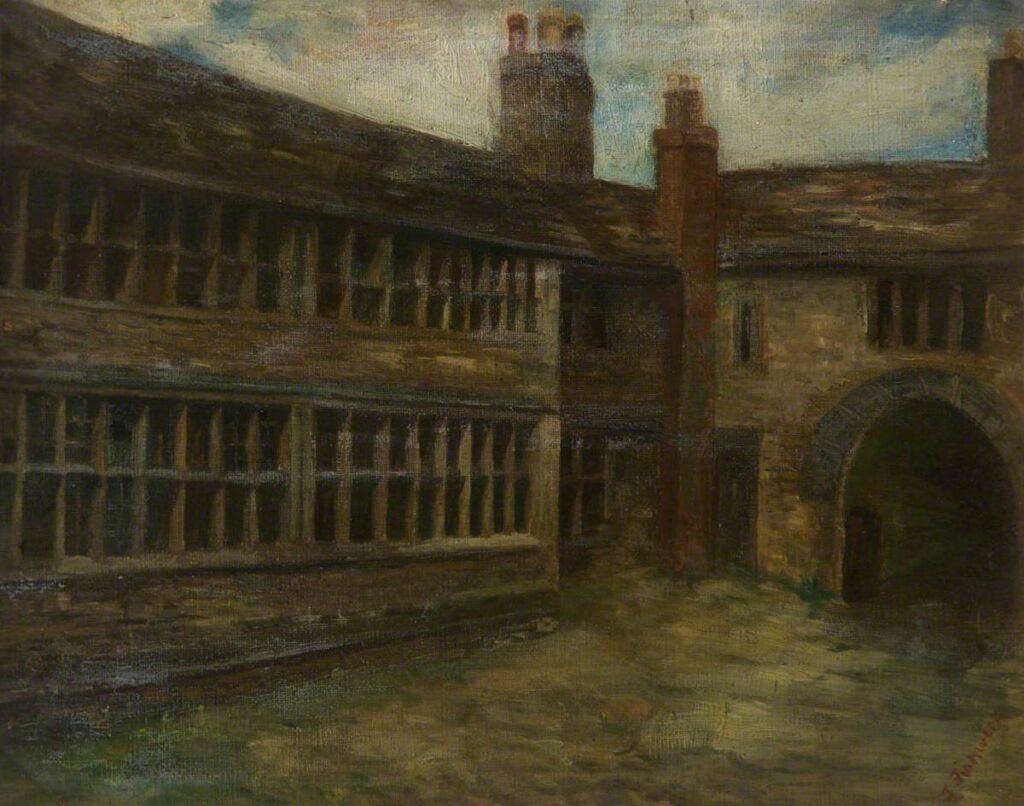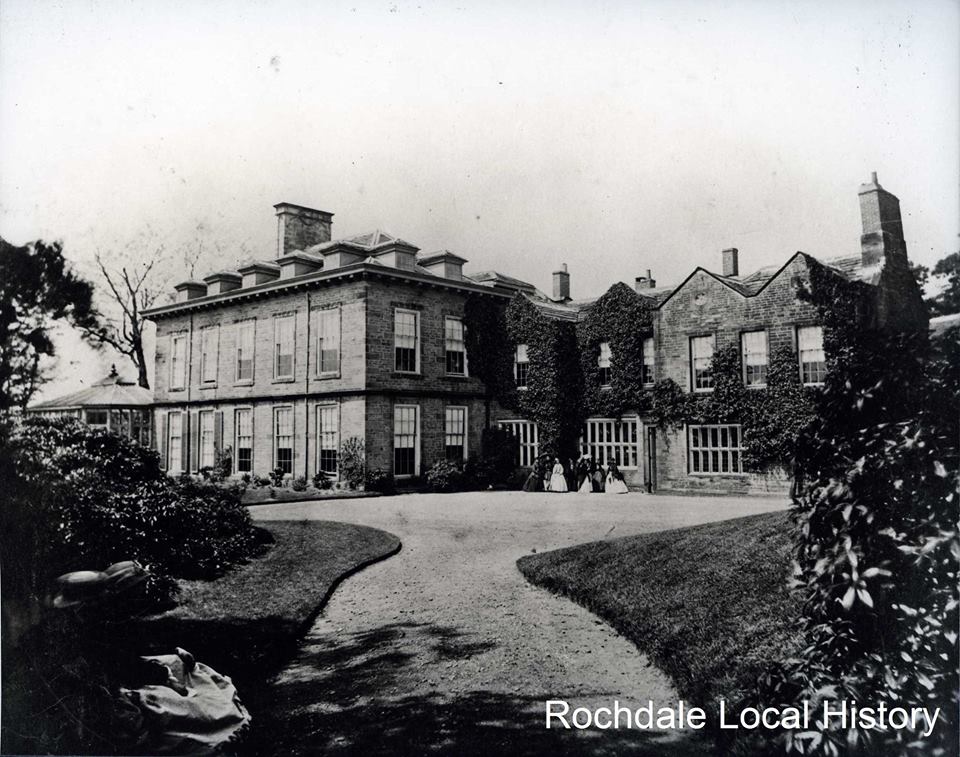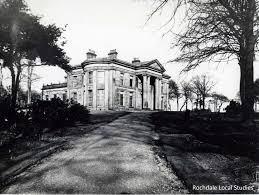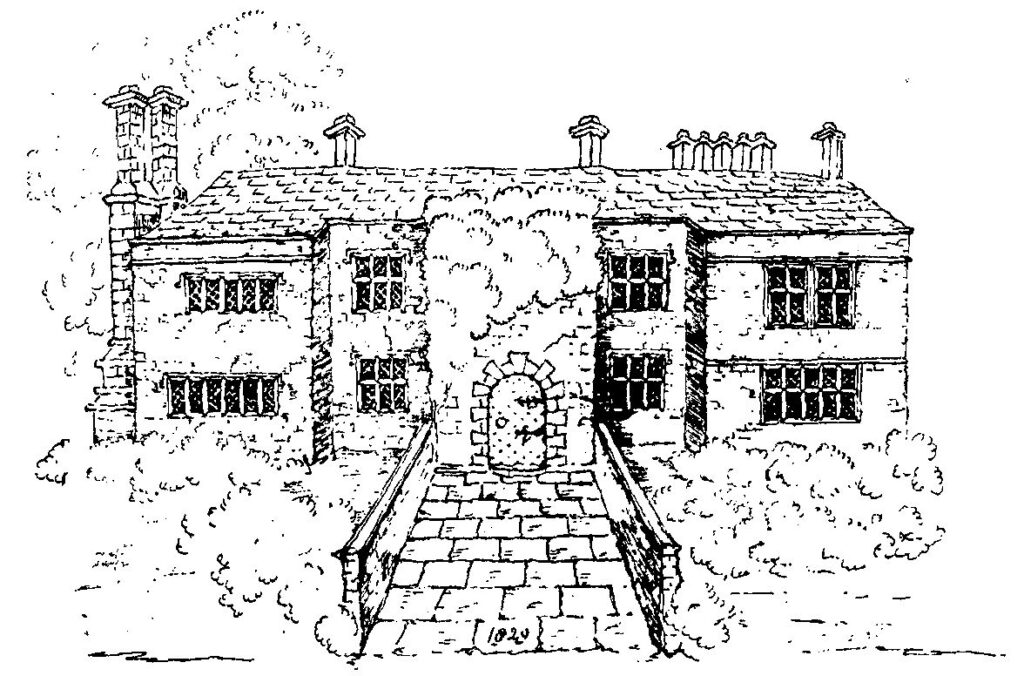Old Halls we have lost

The Orchard (The Manor House)
Purchased by Sir John Byron in 1638, the Manor House, otherwise known as The Orchard remained in the Byron family until it was sold to James Dearden and then passed to Jeremy Dearden who was Lord of the Manor. In the 19th century Rochdale was without an official Manor House because the town was not seen as a ‘Manor’ in the traditional sense but a collection of the many estates that had been mentioned in the Domesday Book. However, the Orchard, named because of its rural links to the country close to the River Roch was extended in 1702 and acquired by Simon Dearden at which time it served as an important centre of local power. The Orchard/Manor House was certainly officially the home of the lords of the manor by 1823, hence its name. Although of little or no architectural distinction it was described as a red-brick building on the north side of the river opposite the town hall to the bottom of Toad Lane. The house was demolished in 1922 and the War memorial now stands on the site of this venerable old house.
Castleton Hall

An association of houses and halls with one or other of the larger families in Rochdale was common knowledge and practice, Castleton Hall for example being linked from as early as the 12th century with the Holt family. Records which go back to the reign of Henry VIII record that Castleton Hall was a wooden structure but included its own stable, ox-house, dove cote gardens, orchards, courts and a private chapel. From 1542 Robert Holt of Stubley who was the High Sheriff of Lancashire until he was relieved of his seat after the Civil War for supporting the King, took possession of Castleton Hall and the house remained within his family until 1715 when it was taken on by Samuel Cheetham of Turton Tower who had married Mary Holt, thereby continuing the hall’s occupancy.
A two-storey, irregularly shaped building with a stream running through its 110 acres of land, the oldest parts of the house as it existed through to the 20th century were dated within the reign of Elizabeth I with its oak-panelled Great Hall thirty by twenty-one feet and its splendid main staircase. Ornate widows featuring local heraldic symbols were said to illuminate rooms that were furnished by expensive tables and book-cases, a grand piano and with expensive curtains at the windows and original oil paintings on the walls.
In 1774 Castleton Hall was sold to Thomas Smith, a Rochdale woollen manufacturer who died there in 1806. Smith’s daughter however, married John Entwistle who then took on the property. Subsequently it was bought by Thomas Champness in the 1890’s, another well-known Rochdale family, who ran the hall with the help of 8 servants. 13 boarders lived in the hall with the Champness family, all of them ‘Joyful News Evangelists.’ Castleton Hall was demolished in 1919
Belfield Hall
A branch of the Butterworth family held Belfield Hall from the 16th century to the 18th century along with 240 acres of land around it after which Richard Townley the High Sheriff took ownership and passed it through his family until Robert Nuttall and then Captain Clement R. N. Beswicke-Royds of Pike House Littleborough took possession.
Elevated above the banks of the Stannybrook stream, Belfield Hall was, so records suggest, a rather squat two storey quadrilateral building with slate roofs which included an 18th century South wing which Colonel Townley added to the original building in 1752. To the front was an 8 foot gateway leading to a quadrangle 46 feet wide overlooked by a huge 16-light bay windows on both ground and upper floors. A sundial was believed to have decorated one of the outer walls with a date of 1619 and above the imposing front door were the arms of the Butterworth family. On the ground floor a room standing to one side of the hallway was a Justice’s Room or Court House. The principal room on the ground floor was 38 feet by 24 complete with a 10 foot inglenook to its west end. The kitchen to the rear had twin modern grates and a fireplace no less than 17 feet wide. In the later 19th century Belfield Hall was untenanted and fell into disrepair, eventually being demolished in 1916.
Buckley Hall
Variously the home of the Buckley and the Entwistle families, its lineage being traceable to Geoffrey de Buckley, Buckley Hall has associations for Rochdale people outside of it being a domestic dwelling. The name itself was alleged to have derived from ‘bleak hill’ which no doubt it once was. The original hall, built before 1626 and having families living in it that had been supports of William the Conqueror was demolished in 1860 and another Buckley Hall built on the same site ‘to the highest standards of opulence and comfort’ by William Whitworth Schofield a local mill owner.
Remaining unoccupied after the death of Schofield in 1882, the Bishop of Salford rescued the hall by persuading the Roman Catholic Church to buy it and adapt it for use as an orphanage. The re-building took place between 1882 and 1888 whereupon Buckley Hall was opened for the occupancy of 28 boys, increased to 80 at a later date. More extension work followed so that the building eventually accommodated 300 children some of whom took part in industrial training after more modification to the hall in 1905. Many trades including plumbing, joinery, woodcarving and boot and shoe repairing were taught at the hall and many of the boys who learned a trade at Buckley Hall eventually married and took root in the town.
After World War II the hall was demolished (for a second time) a new building put up in its place and the orphanage closed as such in 1947 thereafter the building was used for young male prisoners until 1986 and more extensively as part of the prison service into the 1990’s, catering in the 21st century for over 400 men.
Bamford Hall

Bamford Hall was located midway between the (now) Ashworth Valley Scout Camp and Bamford Chapel on Norden Road. Although a hall was recorded as existing in the Bamford area in the 13th century a re-build was certainly completed in the Elizabethan era on the northern edge of a medieval park which was featureless until into the 19th century when it was developed by Joseph Fenton, a leading figure in the development of Rochdale’s textile industry who had taken ownership in 1816. Fenton built a new hall with stables and an entrance lodge in the classical revival style with trees, bushes and meadowland surrounding, bounded by a perimeter wall. As part of the grounds to the old hall there was a pond to the north which was once used to water horses and which would have been a feature of the park landscape flowing as it does through the grounds and out to meet Naden Brook.
The hall was purchased by Edward Stocks Massey in 1888 and later by Alderman David Healey. Rochdale-born Professor Fred Hall who became Principal of Holyoake College (the Co-operative College) in the centre of Manchester took possession of Bamford Hall in 1931 and died there in 1938. During the Second World War the hall was used as a military hospital and purchased by Heywood Corporation in 1946.
The old hall was demolished in 1951 by James Berry Ltd who had connections to the management of the Norden Riviera, and two replacement halls – Bamford Hall and Bamford Old Hall – erected in its place using stones from the original building.
Schofield Hall

Schofield Hall stood at Rakewood near Littleborough and has been, so records from Fishwick’s History of Rochdale suggest, passed down through the centuries from Alan de Hollingworth, through Adam de Turnagh who owned an ‘oxgang of land’ (which was about 15 acres) and thereafter to the ‘Scholefield’ family of Hollingworth. At that time and for many years it stood in the township of Butterworth. The names of these early owners suggest historical lines back to the Norman conquest and its subsequent land settlements, so we have John de Scholefield in the 13th century passing the hall onto his four sons John, William, Adam and Richard in the time of Richard II which would date it to the 14th century from which time it stayed in the Scholefield or Schofield family until the 1700’s. In that century – in 1673 – the hall was sold to Seth Clayton and later in 1770 to Robert Entwistle of Foxholes, that family also owning nearby Buckley Hall at one time. The site of the Hall has some field boundaries but little trace of the hall remains.